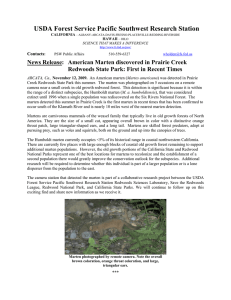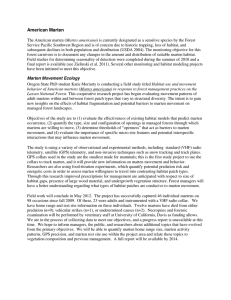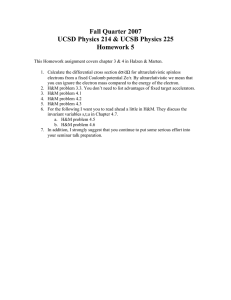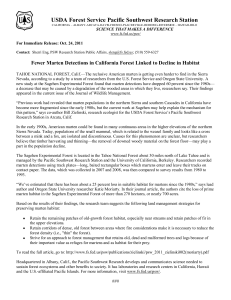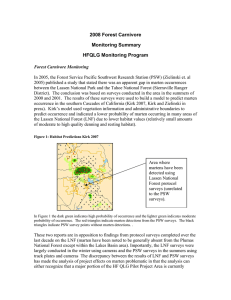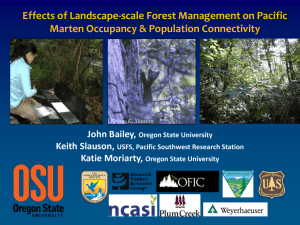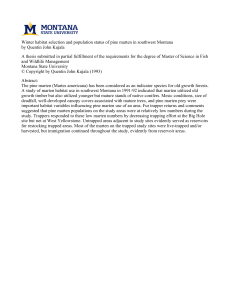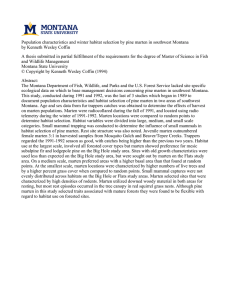HFQLG Monitoring- Marten FY 2009 Martes americana
advertisement
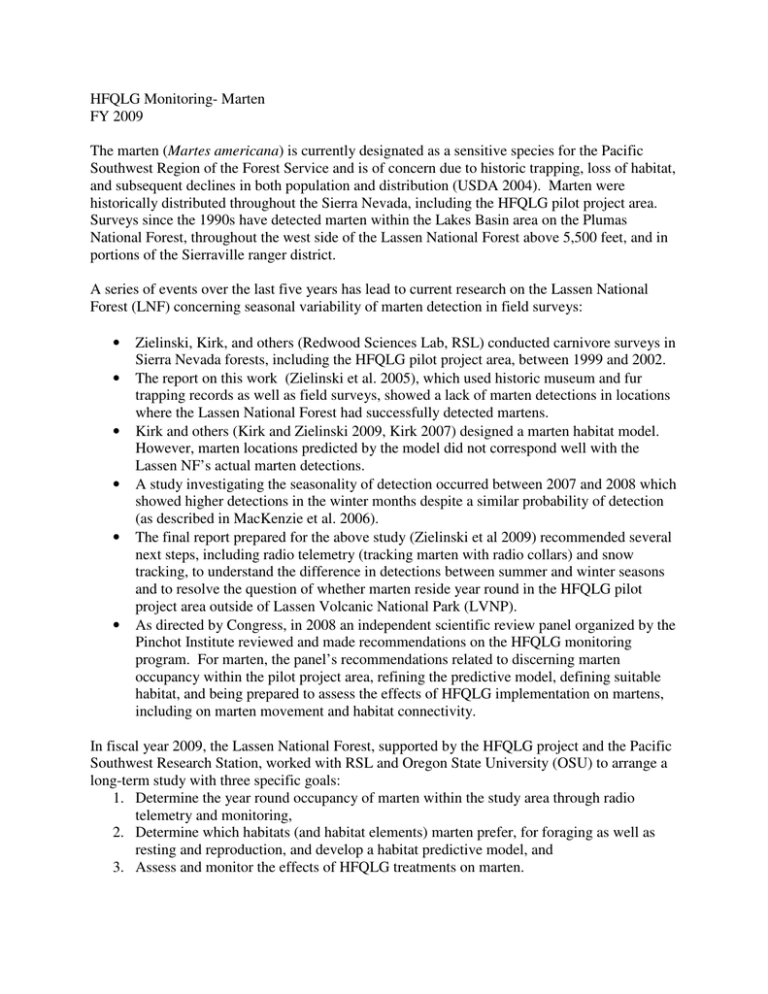
HFQLG Monitoring- Marten FY 2009 The marten (Martes americana) is currently designated as a sensitive species for the Pacific Southwest Region of the Forest Service and is of concern due to historic trapping, loss of habitat, and subsequent declines in both population and distribution (USDA 2004). Marten were historically distributed throughout the Sierra Nevada, including the HFQLG pilot project area. Surveys since the 1990s have detected marten within the Lakes Basin area on the Plumas National Forest, throughout the west side of the Lassen National Forest above 5,500 feet, and in portions of the Sierraville ranger district. A series of events over the last five years has lead to current research on the Lassen National Forest (LNF) concerning seasonal variability of marten detection in field surveys: • • • • • • Zielinski, Kirk, and others (Redwood Sciences Lab, RSL) conducted carnivore surveys in Sierra Nevada forests, including the HFQLG pilot project area, between 1999 and 2002. The report on this work (Zielinski et al. 2005), which used historic museum and fur trapping records as well as field surveys, showed a lack of marten detections in locations where the Lassen National Forest had successfully detected martens. Kirk and others (Kirk and Zielinski 2009, Kirk 2007) designed a marten habitat model. However, marten locations predicted by the model did not correspond well with the Lassen NF’s actual marten detections. A study investigating the seasonality of detection occurred between 2007 and 2008 which showed higher detections in the winter months despite a similar probability of detection (as described in MacKenzie et al. 2006). The final report prepared for the above study (Zielinski et al 2009) recommended several next steps, including radio telemetry (tracking marten with radio collars) and snow tracking, to understand the difference in detections between summer and winter seasons and to resolve the question of whether marten reside year round in the HFQLG pilot project area outside of Lassen Volcanic National Park (LVNP). As directed by Congress, in 2008 an independent scientific review panel organized by the Pinchot Institute reviewed and made recommendations on the HFQLG monitoring program. For marten, the panel’s recommendations related to discerning marten occupancy within the pilot project area, refining the predictive model, defining suitable habitat, and being prepared to assess the effects of HFQLG implementation on martens, including on marten movement and habitat connectivity. In fiscal year 2009, the Lassen National Forest, supported by the HFQLG project and the Pacific Southwest Research Station, worked with RSL and Oregon State University (OSU) to arrange a long-term study with three specific goals: 1. Determine the year round occupancy of marten within the study area through radio telemetry and monitoring, 2. Determine which habitats (and habitat elements) marten prefer, for foraging as well as resting and reproduction, and develop a habitat predictive model, and 3. Assess and monitor the effects of HFQLG treatments on marten. The study will begin in fiscal year 2010 with trapping, radio-collaring, and snow tracking of marten in two discrete study areas. In addition to this data, two separate observations of a marten den site and marten adult (both in summer 2009), as well as prior studies (Ellis 1998), suggest that marten may occupy areas outside LVNP year round. Subsequent work will investigate marten movement in and near HFQLG treatment areas as well as natural openings. Researchers will use snow tracking and radio telemetry to analyze whether and how martens use and/or travel across managed areas (DFPZs, group selections, etc). Another objective of the HFQLG marten monitoring program is to develop a more site-specific predictive model for marten. Understanding of seasonal variations in detection from the ongoing study, along with analysis of winter detection locations, vegetation and other habitat elements, will be incorporated into a regional marten habitat suitability model. This model can then be used for future HFQLG project planning and impact assessment.
